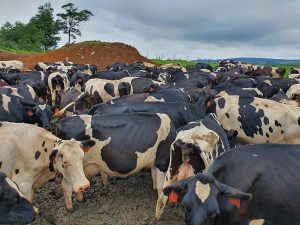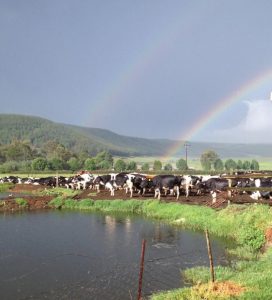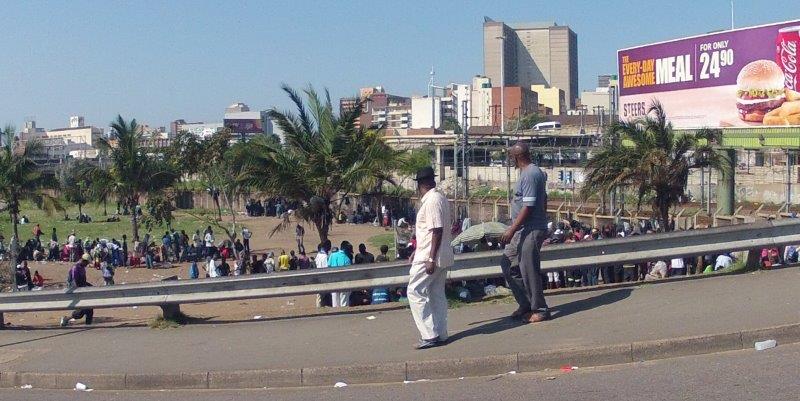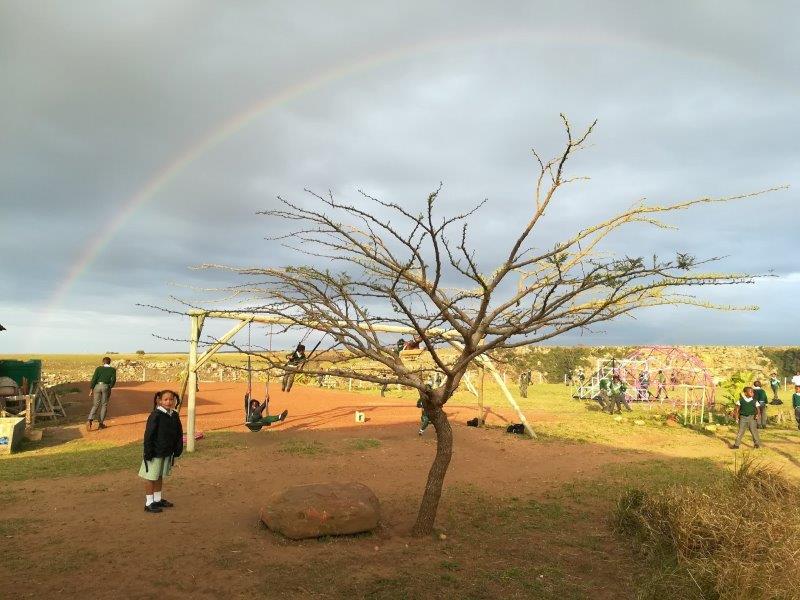Times have long been tough for the country’s dairy farmers, squeezed between rising costs and flat prices. Under lockdown they are, for the most part, bearing up well. Fatima Khan reports
THERE MAY BE some gaps on your supermarket’s shelves right now, but milk and its byproducts are for the most part plentiful and that’s thanks to farmers like Colin Wellbeloved.
A dairy farmer in the KwaZulu-Natal Midlands and chairman of the Milk Producers’ Organisation (MPO), Wellbeloved was upbeat.
“Lockdown hasn’t changed much for us. We’ll keep producing food come hell or high water. I am grateful we are allowed to continue generating income, but also a little envious that there is less time for rest,” he said.
The MPO has started a charity called Project 1, with farmers asked to donate up to 1% of their milk production over the next five months.
Farmers had been donating milk to ‘desperate people by the bakkie and truckload’, said Wellbeloved, with over 300 000 litres of milk already pledged and “hundreds of thousands of rands”. Their target was to donate 3 million litres.
But even as they strive to help neighbouring communities in need, the longer-term prospects for the country’s more than 1 600 dairy farmers and their 45 000 employees remain uncertain.
Demand for dairy has dried up in some quarters, such as from school feeding schemes. But there has been growth in others, including sales of long-life milk to hoarding households.
Shocks
The industry was facing “simultaneous supply and demand shocks”, with disruptions to deliveries and a fall in demand with the closure of restaurants, fast food outlets and coffee shops, according to economist Ronney Ncwadi.
Ncwadi, who is the professor of economics and director of the School School for Economics, Development and Tourism, at the Nelson Mandela University, said the dairy sector had already been buffeted by the lockdown.
“(It) faces simultaneous supply and demand shocks. Due to panic buying prior to the lockdown, shelves in many grocery stores might have been left with low levels of supply and in some cases empty, leading to inevitable price increases,” he told Roving Reporters.
Ncwadi said restrictions on the movement of labour hampered the delivery of dairy products. And because these products were perishable it may force some farmers to dump.
Were this to happen it was not clear who might compensate them, he said.
“The closure of restaurants, fast foods and coffee shops puts a further downward pressure in demand for dairy products. Limited buying of essentials including groceries is insufficient to cover the costs of production in the dairy industry,” said Ncwadi.
The closing of international borders limited exports which could lead to job losses in the sector, he said.
Recently, the Milk Producers’ Organisation (MPO) expressed concern the lockdown may harm sales.
This had already happened in a number of countries, including Britain, where a reported 5 million litres of milk were being dumped a week as restaurants and cafes shut shop.
“To avoid this, the MPO is appealing to retailers to reduce the price of milk products on their shelves to make milk and milk products affordable for everyone during this extremely challenging period,” it said in a statement.
Flat white
On the other hand, a manager at a well-known KwaZulu-Natal dairy, who spoke on condition of anonymity, noted a growing demand as cash-strapped consumers sought value in dairy products.
The lockdown, he told Roving Reporters, had come at a time when South Africa’s milk stocks were at its lowest. This had buoyed production, although prices remained flat.
He felt comparing the South African dairy industry with those in other countries was misleading.
“We must not forget that Covid-10 came when the milk supply in the country was at its lowest, so all milk has been sold – not like the Northern Hemisphere where the farmers had to throw milk away,” he said.
He said if a second wave of Covid-19 cases swamped the country in September/October South African dairy farmers would be at the peak of their summer production.
He countered the decline in milk sales to the hospitality industry and school feeding schemes by noting a growth in other areas.
“Consumers have changed their buying patterns: less fresh milk, more UHT (long-life milk). School feeding schemes have stopped (but) lower income groups are buying (more) maize meal and maas. Maas sales are showing a significant increase.
“Consumers are recognising the value of dairy on their menu,” he said.
But the bad news for producers was that an increase to the retail prices of dairy which was normal at this time of the year to pay farmers, was “not happening” because of Covid-19.
He stressed dairy processing companies were applying strict measures to minimise the risks of infection to their staff.
He did not foresee problems with managing the supply chain, but said companies had measures in place.
***

WHEN WE FIRST met Wellbeloved the virus was something happening to other people, on the other side of the world.
Dairy farmers, understandably, were more concerned with the gradual but insidious squeeze on their profitability.
Wellbeloved’s 330 hectare dairy farm, Melrose, is in beautiful countryside near the small town of Boston.
We passed Frieslands grazing in a verdant Kikuyu pasture. To the left of the farm road, unused equipment lay outside a shed with a few broken windows. A little further on, we reached the farmhouse and milking shed.
Near the farmhouse, a profusion of yellow roses drew the eye. Calf manure, we later learnt, was the secret to the prize-winning flowers. It was a variety called South Africa, one that experts at The Gardener say endures.
Two dogs ambled up, sniffing the car curiously before coming to be petted. Following them was Wellbeloved.
The 42-year-old has been farming here, just off the R617, between the N3 and the Drakensberg, for the past 20 years.
He welcomed us into the farmhouse – comfortable, though hardly lavish – and we sat at the dining room table where papers had been spread out.
Joining us was another farmer, from the Underberg district.
The dairy industry was close-knit and farmers generally had few options when it came to selling their produce, so he asked to remain anonymous.
“Farmers are mostly born farmers. It’s a love of the land and animals,” said the Underberg farmer.
Wellbeloved, himself the son of a farmer, agreed.
But as we soon learnt, the limits of that love had been tested in recent years.
Long climb
For many of KwaZulu-Natal’s 221 milk producers, making a living had come to resemble the R617, which passes through Boston as it cuts through the province’s dairy heartland on its way to the Berg – a long climb, with the odd pothole thrown in.
It varied from district to district, province to province, but the figures for the country as a whole make a fairly consistent point: dairy farmers are under pressure.
From 2009 to 2018 their numbers nationally have fallen, from 3 551 to 1 634.
Farming has become less profitable and farms were becoming concentrated in fewer hands, as the survivors pursued economies of scale.
The cost of feed, fuel and other key inputs have outstripped inflation. Meanwhile, the price farmers get for their milk has grown but modestly.
In January 2018, the price paid to producers inched up to R5,20 a litre. It was the highest level since 2014, according to the Milk Producers’ Organisation.
In debt
But with the retail price often nearly treble this, farmers feel aggrieved.
To stay in business, they have gone increasingly in debt.
In the 2018/2019 period, farmers’ (not only dairy) debt totalled R 181 billion, with R108.78 billion owing to commercial banks.
In the period 1980 to 2016, South Africa’s farm debt has been rising at an average rate of 2 percent per annum, reaching R144 billion in real terms in 2016 – a record level, according to Wandile Sihlobo, chief economist of the Agricultural Business Chamber of South Africa.
The Underberg farmer was among the many feeling the pinch.
“I did not pay a bonus last year, but extended my overdraft this year to pay a small bonus,” he said, voice choked with emotion.
In an earlier interview, the same farmer on the same subject, said: “My guys have been with me for a long time. Do you know how I feel when I can’t look after them?’
At the dining room table he spoke about collusions and cartels in the industry, claiming some supermarkets and processors were involved in price-fixing.
And he was bitter about what he said was a lack of support from the government, remarking that as things stood, there was little chance of emerging farmers getting into the business.
In an earlier interview, Wellbeloved said he would be devastated to learn of collusion or uncompetitive behaviour among milk processors. There had been incidents in the past, but he believed these had been dealt with.
Evidence
Alwyn Kraamwinkel, chief executive of South African Milk Producers’ Organisation, was emphatic.
They had received no information to support claims of anti-competitive behaviour, he said.
He said his organisation, which represented about 130 members, was in favour of a free market.
“The secondary dairy industry regards competition, which is in harmony with the Competition Act, as essential to ensure the effective working of the markets for unprocessed milk and the different dairy products,” he said.
Any concerns about uncompetitive behaviour, backed by evidence, should be submitted to the Competition Commission, said Kraamwinkel.
He was anxious that unsubstantiated claims not be allowed to tarnish the industry’s value-for-money reputation.
Wellbelloved and the Underberg farmer’s concerns about a lack of government support were harder to dismiss, though.
Support lacking
Beyond R495 million to improve compliance with biosecurity and support exports, R500 million for drought and flood relief and R500m for finalising land restitution cases over the medium term, this year’s national budget offered little in the way of direct support for farmers.
This was against a background of subsidies and support declining over decades for South African farmers, including dairymen.
According to Requier Wait, head of economics and trade for Agri SA, the industry association, South African farmers were among the least subsidised in the world.
In a poll of 26 producer countries they ranked 18th, behind farmers in Kazakhstan but, above those in Australia, with Norway, Iceland, Korea, Switzerland, and Japanese farmers receiving the most government support.
It was not ever thus.
The South African dairy industry was once among the most regulated in the world.
Some 30 years ago the then Dairy Industry Control Board enjoyed exclusive rights to sell milk at a fixed price. Milk producers were paid fixed prices and prices were determined and adjusted periodically by the minister of agriculture in consultation with the board.
Price-takers
Dairy farmers have become what economists call price-takers: They must accept the prevailing prices and were largely unable to influence the market.
It was a global phenomenon, said Theo de Jager, executive board chair of the Southern African Agri Initiative and president of the World Agricultural Organisation, in a statement to Roving Reporters.
“All over the world dairy farmers are complaining about the same issue – distributors and retailers each pocket more than the producers, and wield unhealthy power over the value chains by determining the price of milk,” he said.
If anything, milk has become a catch line or loss leader. These are products, often staples, that supermarkets discount to lure shoppers with the hope of getting them to buy other goods with higher markups.
***

ALL THIS TALK of prices, collusions and cartels was becoming oppressive and I asked if we could leave the table for a look around the farm, starting with the milking shed.
The Underberg farmer needed to return to his home and Jersey herd.
We left the farmhouse and stood a while beneath leaden skies. As goodbyes go, it was a prolonged one, with the two men soon talking shop.
When the first few drops of a drizzle began to fall the farmers were still discussing dam levels and the unseasonal weather.
The Kikuyu pastures near the entrance to Melrose owed their lushness to recent rains, but Wellbeloved and the Underberg farmer said that this had followed a long dry spell.
Spring had been unusually dry and autumn uncommonly wet, they agreed.
“It is playing havoc with our fodder flows,” said Wellbeloved, “Most farmers accept that climate change is a reality that affects our production costs and efficiency.”
Tipping point
Talk of dam levels and rain led to mention of the nearby Umkhomazi River and how it marks a “tipping point” in transport economic terms.
Beyond where the R617 crosses the river, near the Impendle Nature Reserve, it starts to make less financial sense to transport raw milk to the diaries near the N3, which serve the major markets in Pietermaritzburg and Durban.
For dairy farmers closer to the Berg it becomes more attractive to process the milk locally, to make cheese or other high value dairy products better able to absorb transport costs.
Thirty tons of cheese, pointed out Wellbeloved, was worth about R3 million, versus R150 000 for 30 tons of raw milk.
The manager of a major KZN dairy (who we quoted earlier) agreed with Wellbeloved’s analysis and he put the transport costs in such far-flung regions at an additional of 20c to 30c a litre.
He felt that apart from cheese, dairies north of Umkomaas should invest in equipment to make milk powder for export to African countries.
The manager, who has many years’ experience in the industry, said each dairy uses a different model for setting the prices it paid farmers.
Volume, butterfat and protein contents were all factors considered, but the prevailing price paid to KZN farmers in January was about R4,50 a litre, he said.
Imbalance
He believed farmers should be getting more, but said a surplus over the past three years had slowed price rises.
While the economy has grown slowly over the period and was now expected to dive because of Covid-19, farmers had been producing more milk, with growth of 5% to 8%, he said.
Apart from an imbalance in supply and demand, milk production was seasonal, said the manager. In spring there is a glut, while in winter, long-life milk fills the gap.
To complicate matters further, the seasons seemed to be shifting and dairies needed to react quickly to this and other factors.
“Dairies can’t delay in negotiating a milk price increase with the supermarkets,” he said, explaining there was only a small winter window when they could increase prices before the “spring flush” dampened prices again.
He predicted milk production would fall this year, which would help firm prices. However, he was speaking before Covid-19 became a factor.
***

AFTER THE UNDERBERG farmer had said his final goodbye, we walked to the milkshed, perhaps 80 metres from the farmhouse.
Here cows were herded into a holding area. Without prompting they lined up, waiting their turn.
Three women farm workers laughed and chatted as they busied themselves, attaching suctioning devices to the cows’ udders.
Soon milk was streaming into collection containers, called receivers.
The equipment is specialised and the process closed. At no stage should the milk come into contact with human hands.
The dairy industry is largely mechanised, nonetheless it employs many people.
Chris van Dijk, chief executive of the Milk Producers’ Organisation, said 45 000 people work in dairies across South Africa. And when the families of farm workers were counted it supported 120 000 people.
Nico Fouché, chief executive of dairy industry umbrella body MilkSA, said a dairy sector task team at Nedlac in 2017 agreed that the difficulties facing the industry were complex and needed the cooperation of business, labour and the government.
Fouché said the following year it was agreed that the Department of Agriculture, Land Reform and Rural Development “must establish a round-table” to address the following problems:
- A lack of capacity in the public sector to frequently inspect and certify milking sheds;
- Issues hampering exports;
- Import protection;
- Inappropriate vaccination programmes;
- Lack of state veterinarians;
- Lack of compliance and enforcement of animal health laws and regulations pertaining to ; and
- Lack of chemical residue monitoring by the Department of Agriculture, Forestry and Fisheries.
“Milk SA is currently liaising with the Department of Agriculture, Land Reform and Rural Development
who must establish the round-table,” said Fouché.
Table, what table?
But it remained unclear when the round table, mooted nearly 3 years ago, would convene.
Roving Reporters sent the department detailed questions, requesting an update on progress made with establishing a round table, but despite reminders, no response was forthcoming at the time of publication.
No measures have been announced specifically to assist the dairy industry since the start of the Covid-19 crisis, however the department had ring-fenced R1.2-billion to help financially distressed small-scale farmers in general.
Wandile Sihlobo, chief economist of the Agricultural Business Chamber of South Africa, noted that cumulative cuts to the interest rate of 225 basis points in the year to date would bring substantial relief for the agricultural sector.
“For a sector that has a record debt of R168-billion, the relief that lower interest rates could bring is substantial. Assuming that all the debt is on flexible interest rates, I estimate that the lower interest rates could bring savings in debt-service costs of about R3.8-billion for farmers over 12 months,” said Sihlobo in a recent opinion piece.
***

AFTER WATCHING THE cows being milked, we went into a stall to see the calves. There were about 10 of them.
Wellbeloved spoke about the short weaning period, typically one week. And the discomfort he felt about having to separate cow and calf earlier than nature intended.
Then it was time for a tour of the lands and we hopped into Wellbeloved’s bakkie.
Back towards the Kikuyu pastures, he pointed with pride to a recently installed irrigation system.
According to economist Requier Wait, a quarter of the country’s food is produced by irrigation and other energy-intensive processes.
These include dairy, horticulture, poultry, grains and agro-processing.
Agriculture spends about R7.3 billion on electricity a year (2018/2019 figures) and load shedding (which has not been a problem since the lockdown) added to the burden.
Wellbeloved said Kikuyu was viable for at most six months of the year. At other times he needed to plant maize and ryegrass silage, but these require irrigation and were more expensive to grow.
We drove back to the house, in time to meet Wellbeloved’s wife, Shelley, who had returned from fetching their two boys, Harry, 11, and Thomas, 5, from primary school.
Family business
Melrose Farm is very much a family business.
Helen Talbot, Wellbeloved’s mother, started it in 1976 with a mixed herd of eight cows, Frieslands, Jerseys, and Guernseys. It grew from there.
But times are changing.
Dairy farms were getting bigger and farmers fewer.
Covid-19 aside, it’s often been hard going for the country’s dairymen.
While some in the dairy processing industry were sympathetic to the lot of farmers, others Roving Reporters canvassed were dismissive, saying “farmers are always crying”.
Either way, there were few signs the road ahead for milk producers was getting any easier.
Will Wellbeloved’s sons follow in his footsteps?
And what of the future of the hundreds of other small and medium-size dairy farms like Melrose?
Time will tell, but meanwhile Wellbeloved is getting on with things. More than 60 days into lockdown, he said, “I am quite proud to be a farmer at the moment.”
There’s a determination about the man. Like those roses near the farmhouse, he trusts they will endure.
The country’s agricultural leaders will need to do much more than hope. – Additional reporting Matthew Hattingh/Roving Reporters

Picture Colin Wellbeloved
- Fatima Khan has a background in laboratory research and education.

Now read… Pizza take-out at centre of sour storm: No whey, man! We’re not dumping
Click on the image below to read more stories in our series of Coronavirus Chronicles













